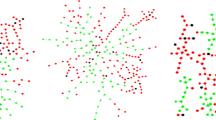Abstract
We study a simple model of a population of agents whose interaction network co-evolves with knowledge diffusion and accumulation. Diffusion takes place along the current network and, reciprocally, network formation depends on the knowledge profile. Diffusion makes neighboring agents tend to display similar knowledge levels. On the other hand, similarity in knowledge favors network formation. The cumulative nonlinear effects induced by this interplay produce sharp transitions, equilibrium co-existence, and hysteresis, which sheds some light on why multiplicity of outcomes and segmentation in performance may persist resiliently over time in knowledge-based processes.
Similar content being viewed by others
References
Abramovitz M (1986). Catching up, forging ahead, and falling behind. J Econ Hist 46:386–406
Albert R, Barabási A-L (2002). Statistical mechanics of complex networks. Rev Mod Phys 74:47–97
Barabási A-L, Albert R (1999). Emergence of scaling in random networks. Science 286:509–512
Barro R, Sala-i-Martin X (1992). Convergence. J Polit Econ 100:223–251
Baumol WJ (1986). Productivity, convergence, and welfare: what the long-run data show. Am Econ Rev 76:1072–1085
DeMarzo P, Vayanos D, Zwiebel J (2003). Persuasion bias, social influence, and unidimensional opinions. Q J Econ 118:909–968
Dorogovtsev SN, Goltsev AV, Mendes JF, Samukhin AN (2003). Spectra of complex networks. Phys Rev E 68:046109
Durlauf S (2003). The convergence hypothesis after 10 years. Research Paper 2003-06. University of Wisconsin, Madison
Durlauf S, Johnson P (2005). Multiple regimes and cross-country growth behavior. J Appl Econom 10:363–384
Ellison G (1983). Learning, local interaction and coordination. Econometrica 61:1047–1071
Eshel I, Samuelson L, Shaked A (1998). Altruists, egoists, and hooligans in a local interaction model. Am Econ Rev 88:157–179
Fagerberg J (1994). Technology differences in growth rates. J Econ Lit 32:1147–1175
Galambos J (1987). The asymptotic theory of extreme order statistics, 2nd edn. Krieger, Melbourne
Galor O (1996). Convergence? Inferences from theoretical models. Econ J 106:1056–1069
Goyal S, van der Leij M, Moraga-Gonzá lez JL (2003)‘Economics: an emerging small world? Working Paper, University of Essex and Erasmus University
Goyal S, Vega-Redondo F (2005). Network formation and social coordination. Games Econ Behav 50:178–207
Grossman J (2002). The evolution of the mathematical research collaboration graph. Congressus Numerantium 158:201–212
Halpin-Healy T, Zhang Y-C (1995). Kinetic Roughening, stochastic growth, directed polymers & all that. Phys Rep 254:215–415
Jackson MO, Watts A (2002). On the formation of interaction networks in social coordination games. Games Econ Behav 41:265–291
Jackson M (2005). A survey of network formation models: stability and efficiency. In: Demange G, Wooders M (eds). Group formation in economics: networks, clubs, and coalitions. Cambridge University Press, Cambridge
Quah DT (1996). Twin peaks: growth and convergence in models of distribution dynamics. Econ J 106:1045–1055
Quah DT (1997). Empirics of growth and distribution: stratification, polarisation, and convergence clubs. J Econ Growth 2:27–59
Marsili M, Vega-Redondo F, Slanina F (2004). The rise and fall of a networked society: a formal model. Proc Nat Acad Sci USA 101:1439–1442
Mankiw NG, Rimer D, Weill D (1992). A contribution to the empirics of economic growth. Q J Econ 107:407–437
Newman MEJ (2001). The structure of scientific collaboration networks. Proc Nat Acad Sci USA 98:404–409
Newman MEJ (2003). The structure and function of complex networks. SIAM Rev 45:167–256
Vega-Redondo F (1997). The evolution of Walrasian behavior. Econometrica 65:375–384
Verspagen B (1991). A new empirical approach to catching up or falling behind. Struct Change Econ Dyn 2:359–380
Weisbuch G, Deffuant G, Amblard F, Nadal J-P (2002). Meet, discuss and segregate! Complexity 7:55–63
Author information
Authors and Affiliations
Corresponding author
Rights and permissions
About this article
Cite this article
Ehrhardt, G., Marsili, M. & Vega-Redondo, F. Diffusion and growth in an evolving network. Int J Game Theory 34, 383–397 (2006). https://doi.org/10.1007/s00182-006-0025-6
Revised:
Published:
Issue Date:
DOI: https://doi.org/10.1007/s00182-006-0025-6




